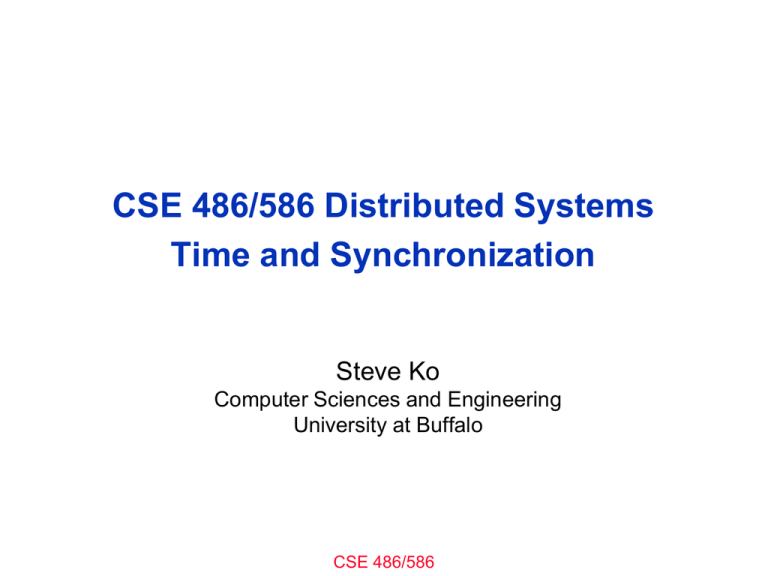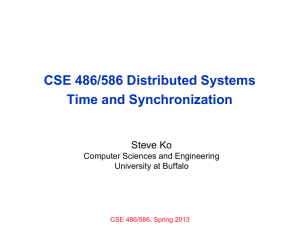CSE 486/586 Distributed Systems Time and Synchronization Steve Ko Computer Sciences and Engineering
advertisement

CSE 486/586 Distributed Systems Time and Synchronization Steve Ko Computer Sciences and Engineering University at Buffalo CSE 486/586 Last Time • Models of Distributed Systems – Synchronous systems – Asynchronous systems • Failure detectors---why? – Because things do fail. • Failure detectors---what? – Properties: completeness & accuracy – Cannot have a perfect failure detector – Metrics: bandwidth, detection time, scale, accuracy • Failure detectors---how? – Two processes: Heartbeating and Ping – Multiple processes: Centralized, ring, all-to-all CSE 486/586 2 Today’s Question • The topic of time – Today and next time • Why? – Need to know when things happen – One of the two fundamental challenges (failure & ordering) • What? – Ideally, we’d like to know when exactly something happened. • How? – Let’s see! CSE 486/586 3 Today’s Question • Servers in the cloud need to timestamp events • Server A and server B in the cloud have different clock values – – – – You buy an airline ticket online via the cloud It’s the last airline ticket available on that flight Server A timestamps your purchase at 9h:15m:32.45s What if someone else also bought the last ticket (via server B) at 9h:20m:22.76s? – What if Server A was > 10 minutes ahead of server B? Behind? – How would you know what the difference was at those times? CSE 486/586 4 Physical Clocks & Synchronization • Some definitions: Clock Skew versus Drift • Clock Skew = Relative Difference in clock values of two processes • Clock Drift = Relative Difference in clock frequencies (rates) of two processes • A non-zero clock drift will cause skew to continuously increase. • Real-life examples – Ever had “make: warning: Clock skew detected. Your build may be incomplete.”? – It’s reported that in the worst case, there’s 1 sec/day drift in modern HW. – Almost all physical clocks experience this. CSE 486/586 5 Synchronizing Physical Clocks • Ci(t): the reading of the software clock at process i when the real time is t. • External synchronization: For a synchronization bound D>0, and for source S of UTC time, S (t ) Ci (t ) D, for i=1,2,...,N and for all real times t. Clocks Ci are accurate to within the bound D. • Internal synchronization: For a synchronization bound D>0, Ci (t ) C j (t ) D for i, j=1,2,...,N and for all real times t. Clocks Ci agree within the bound D. • External synchronization with D Internal synchronization with 2D • Internal synchronization with D External synchronization with ?? CSE 486/586 6 Clock Synchronization Using a Time Server mr mt p Time server,S CSE 486/586 7 Cristian’s Algorithm • Uses a time server to synchronize clocks • Mainly designed for LAN • Time server keeps the reference time (say UTC) • A client asks the time server for time, the server responds with its current time T, and the client uses the received value T to set its clock • But network round-trip time introduces an error. • So what do we need to do? – Estimate one-way delay CSE 486/586 8 Cristian’s Algorithm • Let RTT = response-received-time – request-senttime (measurable at client) • Also, suppose we know – The minimum value min of the client-server one-way transmission time [Depends on what?] – That the server timestamped the message at the last possible instant before sending it back • Then, the actual time could be between [T+min,T+RTT— min] T min min RTT Request sent CSE 486/586 Response received 9 Cristian’s Algorithm • (From the previous slide), the accuracy is: +-(RTT/2 – min) • Cristian’s algorithm – A client asks its time server. – The time server sends its time T. – The client estimates the one-way delay and sets its time. » It uses T + RTT/2 • Want to improve accuracy? – Take multiple readings and use the minimum RTT tighter bound – For unusually long RTTs, ignore them and repeat the request removing outliers CSE 486/586 10 CSE 486/586 Administrivia • Please start PA2-A. • Please use Piazza; all announcements will go there. – If you want an invite, let me know. • Please come to my office during the office hours! – Give feedback about the class, ask questions, etc. CSE 486/586 11 The Network Time Protocol (NTP) • Uses a network of time servers to synchronize all processes on a network. • Designed for the Internet • Why not Christian’s algo.? • Time servers are connected by a synchronization subnet tree. The root is in touch with UTC. Each node synchronizes its children nodes. • Why? Primary server, direct sync. 1 Secondry servers, sync’ed by the primary server 2 2 3 3 3 2 3 CSE 486/586 3 3 Strata 3, sync’ed by the secondary servers 12 Messages Exchanged Between a Pair of NTP Peers (“Connected Servers”) Server B Ti-2 Ti-1 Time m m' Time Server A Ti- 3 Ti • Each message bears timestamps of recent message events: the local time when the previous NTP message was sent and received, and the local time when the current message was transmitted. CSE 486/586 13 The Protocol Server Ti-2 Ti-1 Time m m' Time Client Ti- 3 Ti • Compute round-trip delay: (Ti – Ti-3) – (Ti-1 – Ti-2) • Take the half of the round-trip delay as the one-way estimate: ((Ti – Ti-3) – (Ti-1 – Ti-2))/2 CSE 486/586 14 The Protocol Server Ti-2 Ti-1 Time m m' Time Client Ti- 3 Ti • Compute offset: Ti-1 + (one-way estimate) - Ti = ((Ti-2 – Ti-3) + (Ti-1 – Ti))/2 • Do this with not just one server, but multiple servers. • Do some statistical analysis, remove outliers, and apply a data filtering algorithm. – Out of the scope of this lecture CSE 486/586 15 Theoretical Base for NTP Server B Ti-2 m Ti-1 Time m' Time Server A Ti- 3 Ti • oi: estimate of the actual offset between the two clocks • di: estimate of accuracy of oi ; total transmission times for m and m’; di=t+t’ CSE 486/586 16 Theoretical Base for NTP Server B Ti-2 Ti-1 Time m m' (with delay t) (with delay t’) Time Server A Ti- 3 Ti First, let's get o : T i-2 = T i-3 + t + o T i = T i-1 + t' -o Þ o = (T i-2 - T i-3 + T i-1 - T i) /2 + (t' -t) /2 Then, get the bound for (t' -t) /2 : Finally, we set : o i = (T i-2 - T i-3 + T i-1 - T i) /2 d i = t + t' = T i-2 - T i-3 + T i - T i-1 Then we get : o i - d i /2 £ o £ o i + d i /2. -t' -t £ t' -t £ t'+t (since t',t ³ 0) CSE 486/586 17 Then a Breakthrough… • We cannot sync multiple clocks perfectly. • Thus, if we want to order events happened at different processes (remember the ticket reservation example?), we cannot rely on physical clocks. • Then came logical time. – First proposed by Leslie Lamport in the 70’s – Based on causality of events – Defined relative time, not absolute time • Critical observation: time (ordering) only matters if two or more processes interact, i.e., send/receive messages. CSE 486/586 18 Events Occurring at Three Processes p1 a b m1 Phy s ic al time p2 c d m2 p3 e f CSE 486/586 19 Summary • Time synchronization important for distributed systems – Cristian’s algorithm – Berkeley algorithm – NTP • Relative order of events enough for practical purposes – Lamport’s logical clocks • Next: continue on logical clocks CSE 486/586 20 Acknowledgements • These slides contain material developed and copyrighted by Indranil Gupta at UIUC. CSE 486/586 21





